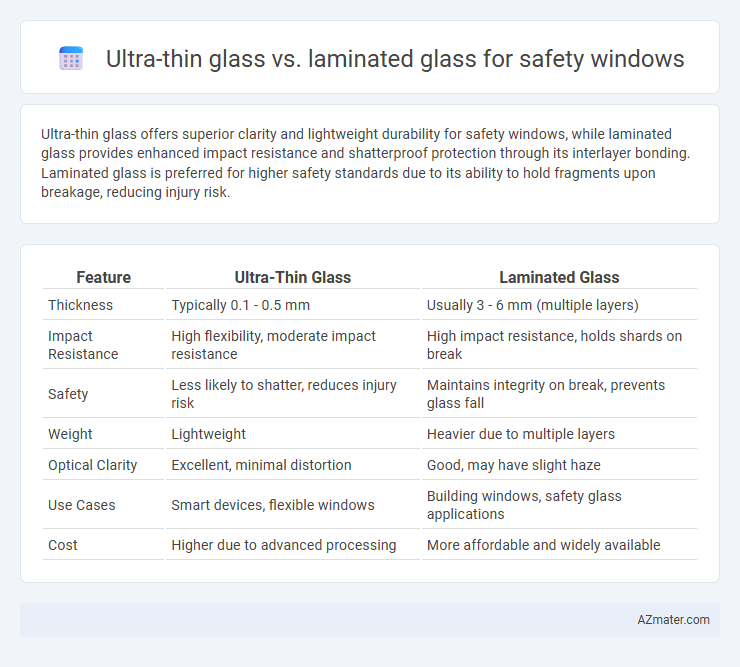Ultra-thin glass offers superior clarity and lightweight durability for safety windows, while laminated glass provides enhanced impact resistance and shatterproof protection through its interlayer bonding. Laminated glass is preferred for higher safety standards due to its ability to hold fragments upon breakage, reducing injury risk.
Table of Comparison
| Feature | Ultra-Thin Glass | Laminated Glass |
|---|---|---|
| Thickness | Typically 0.1 - 0.5 mm | Usually 3 - 6 mm (multiple layers) |
| Impact Resistance | High flexibility, moderate impact resistance | High impact resistance, holds shards on break |
| Safety | Less likely to shatter, reduces injury risk | Maintains integrity on break, prevents glass fall |
| Weight | Lightweight | Heavier due to multiple layers |
| Optical Clarity | Excellent, minimal distortion | Good, may have slight haze |
| Use Cases | Smart devices, flexible windows | Building windows, safety glass applications |
| Cost | Higher due to advanced processing | More affordable and widely available |
Introduction: Ultra-thin Glass vs Laminated Glass
Ultra-thin glass offers exceptional flexibility and lightweight properties, making it ideal for modern safety windows requiring slim profiles without compromising strength. Laminated glass enhances safety through its multi-layered construction, combining glass sheets with interlayers that prevent shattering upon impact. Both materials provide advanced protection, but ultra-thin glass emphasizes minimal thickness and adaptability, while laminated glass prioritizes durability and impact resistance.
Composition and Manufacturing Process
Ultra-thin glass consists of a single, flexible layer of glass typically less than 0.3 mm thick, produced through advanced float glass or down-draw methods ensuring minimal thickness and high strength. Laminated glass is composed of two or more glass layers bonded together with an interlayer, often polyvinyl butyral (PVB) or ethylene-vinyl acetate (EVA), processed through heat and pressure to enhance impact resistance and safety performance. The manufacturing of laminated glass involves stacking and pressing glass sheets with the interlayer, while ultra-thin glass requires precise control during formation to achieve durability without lamination.
Strength and Durability Comparison
Ultra-thin glass offers exceptional flexibility and high tensile strength, making it resistant to cracking under stress, while laminated glass combines multiple layers of glass and interlayers to provide superior impact resistance and hold shards together upon breakage. Laminated glass generally outperforms ultra-thin glass in durability due to its multi-layer construction that enhances resistance to penetration and maintains structural integrity after impact. Strength-wise, ultra-thin glass excels in flexibility and lightness, whereas laminated glass remains the preferred choice for maximum safety and long-term durability in safety window applications.
Impact Resistance and Safety Features
Ultra-thin glass offers superior impact resistance due to its flexibility and ability to absorb shocks without shattering, making it ideal for safety windows in high-risk environments. Laminated glass enhances safety by sandwiching a polyvinyl butyral (PVB) layer between glass sheets, which holds fragments together upon impact, preventing ejection of glass shards and reducing injury risk. Both materials provide effective safety features, but ultra-thin glass excels in impact absorption while laminated glass prioritizes post-impact integrity and occupant protection.
Weight and Design Flexibility
Ultra-thin glass offers significant weight reduction compared to laminated glass, enhancing ease of installation and reducing structural load in safety window applications. Its slim profile allows greater design flexibility, enabling architects to create sleek, minimalist aesthetics without compromising strength. Laminated glass, while heavier due to multiple layers, provides excellent impact resistance and sound insulation but limits design options due to its thickness.
Optical Clarity and Transparency
Ultra-thin glass offers superior optical clarity and high transparency due to its minimal thickness, reducing light distortion and maintaining a clear view in safety windows. Laminated glass, composed of multiple layers with interlayers, provides enhanced impact resistance but may slightly compromise transparency due to the interlayer's presence. For applications prioritizing visual acuity and unobstructed light transmission, ultra-thin glass is the optimal choice over laminated glass in safety window installations.
Thermal and Acoustic Insulation Properties
Ultra-thin glass, with its reduced thickness typically between 0.1 to 0.4 mm, offers excellent thermal insulation by minimizing heat transfer while maintaining transparency, making it ideal for energy-efficient safety windows. Laminated glass combines multiple glass layers bonded with a plastic interlayer, significantly enhancing acoustic insulation by dampening sound vibrations and providing superior impact resistance for safety applications. Both materials contribute to safety windows, but laminated glass excels in noise reduction and impact absorption, whereas ultra-thin glass prioritizes thermal performance and lightweight design.
Cost Analysis and Investment Value
Ultra-thin glass offers a premium cost profile with higher upfront expenses due to advanced manufacturing processes compared to laminated glass, which remains more affordable for large-scale safety window applications. Investment value favors ultra-thin glass when durability, weight reduction, and aesthetic appeal contribute to long-term savings in energy and structural support costs. Laminated glass, while less costly initially, may incur higher maintenance or replacement expenses over time due to lower impact resistance and shorter lifespan.
Environmental Sustainability and Recyclability
Ultra-thin glass offers enhanced environmental sustainability through reduced raw material usage and lighter weight, which lowers transportation emissions compared to traditional laminated glass. Laminated glass, composed of multiple layers bonded with polyvinyl butyral (PVB) interlayers, poses challenges in recyclability due to the difficulty in separating materials for reuse. Ultra-thin glass's simpler, single-material composition improves recyclability rates, making it a more eco-friendly choice for safety window applications.
Ideal Applications: Choosing the Right Glass for Safety Windows
Ultra-thin glass offers superior flexibility and weight advantages, making it ideal for high-technology applications such as smartphones, wearable devices, and automotive displays where space and weight are critical. Laminated glass excels in safety applications requiring enhanced impact resistance and shatterproof performance, commonly used in building facades, skylights, and automotive windshields to protect occupants and enhance security. Selecting the right glass for safety windows depends on specific needs: ultra-thin glass suits compact, lightweight designs, while laminated glass is preferable for robust protection against impacts and forced entry.

Infographic: Ultra-thin glass vs Laminated glass for Safety window
 azmater.com
azmater.com